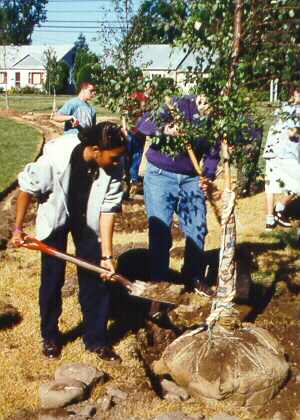| New Jersey Division of Fish and Wildlife |
|
Hackettstown High School biology teacher Bob Vellucci had trout in mind, too, when he incorporated the study of the Musconetcong into his Biology, Earth Science and Selected Science Topics classes for 9th through 12th graders. Students sampled the river at the cemetery and were surprised by the high diversity of aquatic life they found. The invertebrates (insects, etc.) they found are important to the trout's diet and indicated that the river is in good shape at that particular reach.
Students also studied the physical factors that determine trout habitat, such as stream profile, water velocity and bank erosion.
Vellucci felt the habitat could be improved, too.  Hamilton, Vellucci and the students formulated a three-phase plan. The first phase involved planting a buffer of trees to shade the stream from harmful summer sun. The next two phases will involve in-stream improvements: stabilizing the bank and installing wing dams to slow the flow of water and create eddies of slower water.
Hamilton, Vellucci and the students formulated a three-phase plan. The first phase involved planting a buffer of trees to shade the stream from harmful summer sun. The next two phases will involve in-stream improvements: stabilizing the bank and installing wing dams to slow the flow of water and create eddies of slower water.
The project got off the ground when the Conservation Partnership stepped in. The Union Cemetery Association, along with USDA Natural Resources Conservation Service, North Jersey Resource Conservation and Development Council, and the Soil Conservation Districts of Morris and Warren counties, as well as the Hackettstown Dept. of Public Works, cooperated to conduct the tree planting on June 4, 1998.
Hamilton, Tim Dunne, Resource Conservationist with USDA NRCS, and Donna Drewes, RC&D Coordinator, initiated the tree planting project by working with the cemetery association to develop a plan. The Hackettstown Dept. of Public Works provided a crew and machinery to dig the holes for the trees. Funding for the project came from in-kind contributions of $8,925, and $4,500 from a US Environmental Protection Agency Section 319 Nonpoint Source Pollution grant administered by the NJ Dept. of Environmental Protection.
The trees that were planted will grow to shade the river and benefit not only the trout that are stocked there, but their aquatic insect food sources as well. Important aquatic insects in the trout's diet include mayflies, caddisflies and stoneflies. Warm water holds less oxygen than cold, and aquatic insects and fish such as trout are intolerant of low oxygen levels. Additionally, the trees will provide habitat for songbirds and other wildlife, and improve the visual aesthetics of the site.
"A totally shaded stream may be ten to twelve degrees cooler on a hot summer day than an unshaded stream reach," said Pat Hamilton. Late summer may be the most stressful time for trout as water temperatures are likely to be at their warmest.
The riparian habitat improvement can only benefit a robust fishing area. The Musconetcong River is one of New Jersey's premier trout waters, and has put Warren County on the map as a fishing destination. Only neighboring Hunterdon and Sussex counties rank higher in the number of fishing trips taken. With expenditures in the county approaching $20 million, freshwater fishing is big business in Warren County, and the ecotourism industry that relies on fishing can only grow as a result of improved habitat.